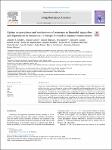Update on prevalence and mechanisms of resistance to linezolid, tigecycline and daptomycin in enterococci in Europe: Towards a common nomenclature
Bender, Jennifer K.
Cattoir, Vincent
Hegstad, Kristin
Sadowy, Ewa
Coque, Teresa M.
Westh, Henrik
Hammerum, Anette M.
Schaffer, Kirsten
Burns, Karen
Murchan, Stephen
Novais, Carla
Freitas, Ana R.
Peixe, Luísa
Del Grosso, Maria
Pantosti, Annalisa
Werner, Guido
Vancomycin-resistant enterococci (VRE) are important nosocomial pathogens. Invasive VRE infections are difficult to treat since common therapeutic options including ampicillin and glycopeptides often fail. In vitro, most VRE remain susceptible to last-resort antibiotics such as linezolid, tigecycline and daptomycin. However, neither tigecycline nor linezolid act in a bactericidal manner, and daptomycin has proven activity only at high dosages licensed for treating enterococcal endocarditis. Despite these pharmacological and therapeutic limitations, reports on resistance to these last-resort drugs in VRE, and enterococci in general, have increased in recent years. In this review, we briefly recapitulate the current knowledge on the mode of action as well as the known and novel mechanisms of resistance and describe surveillance data on resistance to linezolid, tigecycline and daptomycin in enterococci. In addition, we also suggest a common nomenclature for designating enterococci and VRE with resistances to these important last-resort antibiotics.
Dateien zu dieser Publikation

